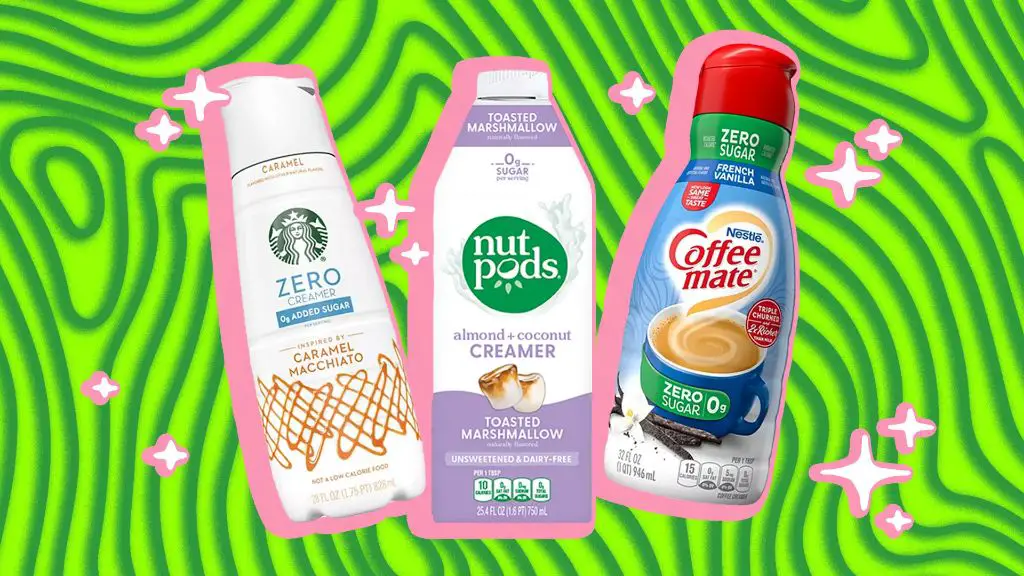Is Creamer A Sweetener?
What is Creamer?
Creamer is a dairy or non-dairy liquid or powder product that is used to lighten the color and flavor of coffee, tea, and other beverages. According to The Spruce Eats, creamer is “made from milk solids, vegetable oils, sweeteners, stabilizers, emulsifiers, and flavors that are mixed together in liquid or dried form” (source).
The main ingredients in creamer are water, vegetable oil, sugar or other sweeteners, milk or milk products, and natural or artificial flavors. Creamers come in liquid, powdered, refrigerated, shelf-stable, dairy, and non-dairy varieties.
The purpose of creamer is to make coffee, tea, and other drinks taste smoother, richer, and less bitter. It lightens the color of the beverage and adds a touch of sweetness and flavor. Creamer provides the texture, mouthfeel, and flavor of cream or milk without curdling when added to hot coffee. Unlike milk or cream, most creamers do not need to be refrigerated.
Types of Creamers
There are several main types of creamers available:
Powdered Creamers
Powdered creamers like Coffee-Mate come in a dried powder form and are made from maltodextrin and vegetable oil. They must be reconstituted with water before adding to coffee or recipes. Powdered creamers are convenient for traveling and have a longer shelf life than liquid creamers (International Delight).
Liquid Creamers
Liquid creamers like International Delight come ready-to-use in a liquid form. They contain oils, milk products, sugars, and flavorings blended together into a creamy liquid. Liquid creamers come in different fat contents like whole milk, 2%, and non-dairy varieties (Real Good Coffee Co).
Flavored Creamers
Flavored creamers have added flavors like French vanilla, hazelnut, caramel, and seasonal flavors like pumpkin spice. Both powdered and liquid creamers come in a wide variety of flavors to customize the taste of coffee and tea beverages (A to Z Glatt Kosher).
Non-Dairy Creamers
Non-dairy creamers provide a lactose-free, vegan alternative to traditional dairy creamers. They are made from plant-based oils like coconut, almond, or soy. Non-dairy creamers have a similar texture and flavor to dairy-based creamers, but without the milk components.
Main Ingredients in Creamer
The main ingredients in creamer include milk products, oil, emulsifiers, and preservatives. Coffee creamers are a common dairy product for whitening and flavoring coffee. The original formulations of creamer contained milk products like sodium caseinate, a milk protein, and lactose. Nowadays, most creamers contain vegetable oils like coconut oil or soybean oil instead of dairy milk. These oils are usually hydrogenated for a thicker consistency. Emulsifiers like mono- and diglycerides are added to help the oils mix with the water evenly and prevent separation. Preservatives like dipotassium phosphate also help extend the shelf life. According to the ingredient list on Coffee mate’s website, their Original Powder Creamer contains “corn syrup solids, hydrogenated vegetable oil (coconut and palm kernel and/or soybean), sodium caseinate (a milk derivative), and less than 2% of dipotassium phosphate, mono- and diglycerides, and artificial flavor.”
Difference Between Creamer and Milk
Creamers and milk are frequently used to lighten the color and soften the flavor of coffee. However, there are some key differences between the two in terms of ingredients, consistency, calories, and taste.
The main difference is that creamers contain vegetable oils, sugars or other flavorings, while milk is a dairy product containing naturally occurring sugars like lactose. According to the food and nutrition site YourDreamCoffee.com, milk has a thicker, creamier consistency compared to liquid creamers which are thinner. Powdered creamers can produce a consistency closer to milk when mixed.
In terms of calories and fat, milk is higher since it contains naturally occurring fats. Whole milk has about 150 calories and 8 grams of fat per cup, while 2% milk has 120 calories and 5 grams of fat. Coffee creamers are lower in both calories and fat, with powdered creamers containing 20-40 calories and 1-2 grams of fat per tablespoon. Fat-free liquid creamers have just 20-40 calories and 0-0.5 grams of fat per tablespoon.
When it comes to taste, the flavorings and sweeteners in creamers make them taste richer and sweeter than regular milk. However, milk provides a more subtle floral, lightly sweet taste that many coffee drinkers prefer over the stronger flavors of creamers. Ultimately taste preferences are subjective, but in general milk provides a more delicate coffee lightening effect compared to creamers.
Is There Sugar in Creamers?
Many creamers contain added sweeteners like sugar or high fructose corn syrup. According to Healthline, “Some popular types of coffee creamer can contain up to 5 grams of added sugar in a single serving. That’s more than 1 teaspoon of sugar.”1 The added sweeteners give creamer a sweeter taste compared to plain milk or half and half.
Some creamers also contain natural sugars like lactose from milk. For example, half and half is made from milk and cream so it has some natural milk sugar. But it does not contain any added sweeteners. As Sweet Peachef notes, “Typical coffee creamer is made without dairy ingredients. The creamer is full of sugar (some brands have up to 5 grams). That doesn’t work out well for your waistline or your blood sugar levels.”2
So in summary, many creamers have added sugars but no natural sugars, while half and half has some natural lactose sugar but no added sweeteners.
Are Creamers Considered Sweeteners?
Even though creamers are blended with oils and milk derivatives, many traditional creamers do contain sweeteners as one of the main ingredients. Granulated white sugar, corn syrup, or artificial sweeteners like sucralose are commonly added to provide a sweet taste and enhance the flavor of coffee (www.healthline.com/nutrition/cream-vs-half-and-half-vs-coffee-creamer). This sweetness helps balance out the bitterness of coffee and makes it more palatable for those who don’t enjoy black coffee.

The primary role of sweeteners in creamers is to sweeten coffee to one’s taste preferences. Most dairy creamers contain about 1-3 grams of sugar per tablespoon, while some flavored non-dairy creamers can have up to 5 grams. This added sweetness is what distinguishes creamers from milk or half-and-half, which don’t contain additional sugars (www.katiecouric.com/health/nutrition/is-coffee-creamer-bad-for-you-healthy-alternatives/).
So in summary, while creamers aren’t exclusively made of sweeteners, traditional dairy and non-dairy creamers do rely on added sugars or artificial sweeteners to sweeten coffee as part of their intended use. Those looking to avoid added sweeteners can find creamer options without sugar or artificial sweeteners.
Nutritional Profile of Creamers
Creamers can have a varying nutritional profile depending on the specific ingredients and type of creamer. Here is an overview of the common nutritional facts found in creamers:
Calories – Creamers contain calories, though the amount can vary. For example, one tablespoon of original Coffee-Mate liquid creamer contains 17 calories, while one tablespoon of Coffee-Mate French Vanilla creamer contains 20 calories.
Fat – Most creamers contain 1-3 grams of fat per serving, depending on the type. This is usually from milkfat ingredients. For example, one tablespoon of liquid coffee creamer contains about 1 gram of fat, both saturated and unsaturated fats (1).
Carbohydrates – Creamers also contain carbohydrates, usually from added sugars. A tablespoon of liquid coffee creamer has around 2 grams of carbs, almost all from sugar (1).
Protein – Most creamers contain little to no protein. For example, a tablespoon of liquid creamer has 0 grams of protein (1).
Health Effects of Creamers
Research suggests that frequent consumption of coffee creamers may negatively impact health, especially related to obesity, diabetes and heart health.
Many coffee creamers are high in added sugars like high fructose corn syrup, which overconsumption of has been linked to weight gain and obesity. According to one study, people who consumed at least 25% of their daily calories from added sugars had a significantly increased risk of obesity (source).
Artificial sweeteners like sucralose and aspartame commonly found in low-calorie coffee creamers may not directly cause weight gain, but research suggests they can still lead to glucose intolerance and increase diabetes risk (source).
The trans fats present in some creamers can negatively impact cholesterol levels and heart health. One study found that trans fat consumption was associated with an increased risk of coronary heart disease (source).
Non-Dairy and Lower Calorie Options
Many people choose non-dairy creamers for dietary reasons or to reduce calories. Popular non-dairy creamer options include:
Almond milk: Almond milk makes a delicious dairy-free creamer. It has a creamy, nutty taste and contains only 30-40 calories per serving (https://www.eatthis.com/healthy-non-dairy-coffee-creamers/). Almond milk creamers provide vitamin E but not much protein or calcium.
Coconut creamer: Coconut creamers lend a sweet, tropical flavor to coffee. Brands like Nutpods contain just 20 calories per tablespoon and no added sugar (https://thebeet.com/best-non-dairy-coffee-creamers/). Coconut creamers are free of lactose, soy, nuts, and gluten.
Stevia-sweetened: Some non-dairy creamers are sweetened with natural stevia rather than sugar. For example, Califia Farms Better Half creamer has just 15 calories and 1g sugar per serving (https://www.amazon.com/Non-Dairy-Coffee-Creamers-Plant-Based/s?keywords=Non-Dairy+Coffee+Creamers). Stevia-sweetened creamers provide sweetness without unwanted calories.
Other popular options include oat milk, cashew milk, and pea protein creamers. Choosing unsweetened varieties helps keep calories and sugar low. Non-dairy creamers provide a lactose-free, low-calorie option for coffee.
Using Creamer in Coffee and Recipes
When using creamer in coffee, it’s generally recommended to use 1-2 tablespoons per 8 oz cup of coffee. This amount can be adjusted based on personal preference for creaminess and sweetness. Many people start with 1 tablespoon of creamer per 8 oz of coffee and adjust from there. Some tips for using creamer in coffee include:
- For hot coffee, add the creamer to the cup before pouring in the hot coffee. This helps blend the creamer evenly.
- For iced coffee, mix the creamer with the coffee as you are brewing it or pour it over ice after brewing. Iced coffee requires a bit more creamer for full flavor.
- Stir or shake the coffee after adding creamer to fully incorporate it.
- Try varying the amount of creamer to adjust the flavor and sweetness.
Creamers can also be used in a variety of recipes and beverages. For baking recipes, substitute an equal amount of creamer for milk. Creamers add richness and sweetness to items like coffee cakes, muffins, quick breads, and more (Source). For smoothies, shakes, or hot chocolate, replace the milk called for in the recipe with creamer. Creamers pair well with chocolate, coffee, caramel, and fall spice flavors.
Some recipe ideas using creamer include:
- Pumpkin spice latte with coffee, pumpkin pie spice, vanilla creamer, and whipped cream
- Creamer-based hot chocolate with chocolate syrup and creamer
- Creamer pumpkin smoothie with pumpkin puree, vanilla creamer, cinnamon
- Creamer banana bread or pumpkin bread using creamer instead of milk
Overall, creamer can be used in a wide variety of hot and cold coffee drinks, baking recipes, smoothies, and more. Adjust the amount to achieve the desired flavor and consistency. Creamers add sweetness, richness, and delicious flavor.





